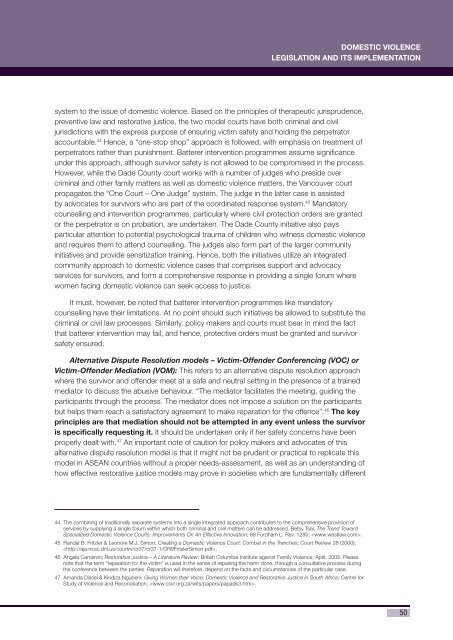Domestic Violence Legislation and its Implementation
Domestic Violence Legislation and its Implementation
Domestic Violence Legislation and its Implementation
Create successful ePaper yourself
Turn your PDF publications into a flip-book with our unique Google optimized e-Paper software.
DOMESTIC VIOLENCE<br />
LEGISLATION AND ITS IMPLEMENTATION<br />
system to the issue of domestic violence. Based on the principles of therapeutic jurisprudence,<br />
preventive law <strong>and</strong> restorative justice, the two model courts have both criminal <strong>and</strong> civil<br />
jurisdictions with the express purpose of ensuring victim safety <strong>and</strong> holding the perpetrator<br />
accountable. 44 Hence, a “one-stop shop” approach is followed, with emphasis on treatment of<br />
perpetrators rather than punishment. Batterer intervention programmes assume signifi cance<br />
under this approach, although survivor safety is not allowed to be compromised in the process.<br />
However, while the Dade County court works with a number of judges who preside over<br />
criminal <strong>and</strong> other family matters as well as domestic violence matters, the Vancouver court<br />
propagates the “One Court – One Judge” system. The judge in the latter case is assisted<br />
by advocates for survivors who are part of the coordinated response system. 45 M<strong>and</strong>atory<br />
counselling <strong>and</strong> intervention programmes, particularly where civil protection orders are granted<br />
or the perpetrator is on probation, are undertaken. The Dade County initiative also pays<br />
particular attention to potential psychological trauma of children who witness domestic violence<br />
<strong>and</strong> requires them to attend counselling. The judges also form part of the larger community<br />
initiatives <strong>and</strong> provide sensitization training. Hence, both the initiatives utilize an integrated<br />
community approach to domestic violence cases that comprises support <strong>and</strong> advocacy<br />
services for survivors, <strong>and</strong> form a comprehensive response in providing a single forum where<br />
women facing domestic violence can seek access to justice.<br />
It must, however, be noted that batterer intervention programmes like m<strong>and</strong>atory<br />
counselling have their limitations. At no point should such initiatives be allowed to substitute the<br />
criminal or civil law processes. Similarly, policy makers <strong>and</strong> courts must bear in mind the fact<br />
that batterer intervention may fail, <strong>and</strong> hence, protective orders must be granted <strong>and</strong> survivor<br />
safety ensured.<br />
Alternative Dispute Resolution models – Victim-Offender Conferencing (VOC) or<br />
Victim-Offender Mediation (VOM): This refers to an alternative dispute resolution approach<br />
where the survivor <strong>and</strong> offender meet at a safe <strong>and</strong> neutral setting in the presence of a trained<br />
mediator to discuss the abusive behaviour. “The mediator facilitates the meeting, guiding the<br />
participants through the process. The mediator does not impose a solution on the participants<br />
but helps them reach a satisfactory agreement to make reparation for the offence”. 46 The key<br />
principles are that mediation should not be attempted in any event unless the survivor<br />
is specifi cally requesting it. It should be undertaken only if her safety concerns have been<br />
properly dealt with. 47 An important note of caution for policy makers <strong>and</strong> advocates of this<br />
alternative dispute resolution model is that it might not be prudent or practical to replicate this<br />
model in ASEAN countries without a proper needs-assessment, as well as an underst<strong>and</strong>ing of<br />
how effective restorative justice models may prove in societies which are fundamentally different<br />
44 The combining of traditionally separate systems into a single integrated approach contributes to the comprehensive provision of<br />
services by supplying a single forum within which both criminal <strong>and</strong> civil matters can be addressed. Betsy Tsai; The Trend Toward<br />
Specialized <strong>Domestic</strong> <strong>Violence</strong> Courts: Improvements On An Effective Innovation; 68 Fordham L. Rev. 1285; .<br />
45 R<strong>and</strong>al B. Fritzler & Leonore M.J. Simon; Creating a <strong>Domestic</strong> <strong>Violence</strong> Court: Combat in the Trenches; Court Review 28 (2000);<br />
.<br />
46 Angela Cameron; Restorative Justice – A Literature Review; British Columbia Institute against Family <strong>Violence</strong>; April, 2005. Please<br />
note that the term “reparation for the victim” is used in the sense of repairing the harm done, through a consultative process during<br />
the conference between the parties. Reparation will therefore, depend on the facts <strong>and</strong> circumstances of the particular case.<br />
47 Am<strong>and</strong>a Dissel & Kindiza Ngubeni; Giving Women their Voice: <strong>Domestic</strong> <strong>Violence</strong> <strong>and</strong> Restorative Justice in South Africa; Centre for<br />
Study of <strong>Violence</strong> <strong>and</strong> Reconciliation; .<br />
50

















